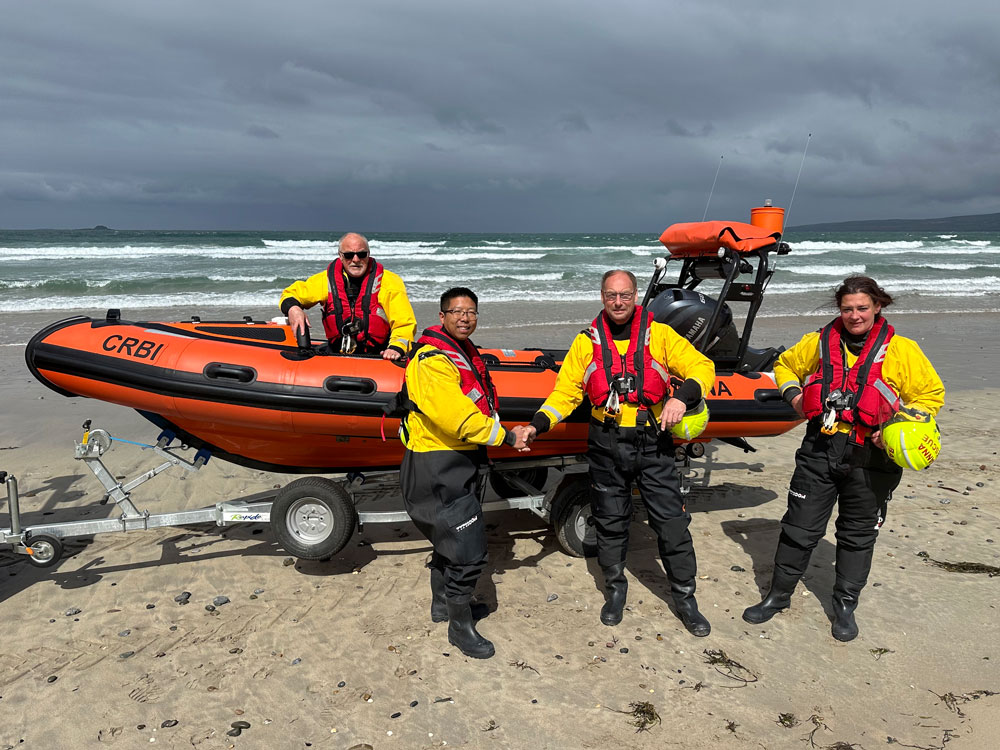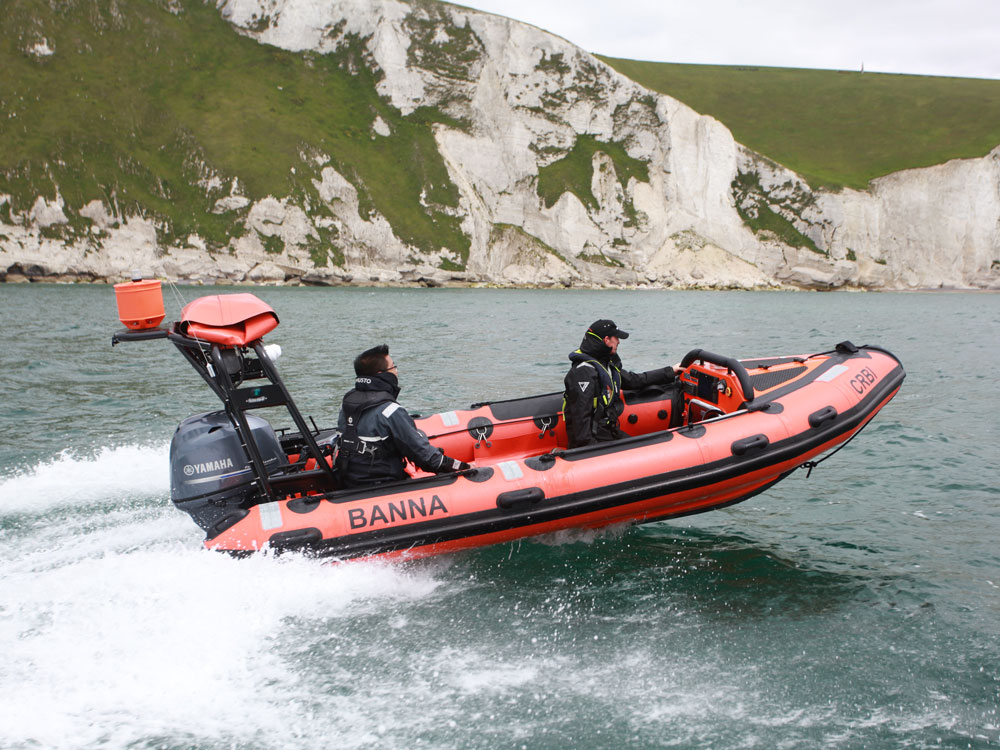Founded in 1983, Banna Rescue has the distinction of being Ireland’s oldest independent lifeboat association. Over the decades, the Kerry-based, volunteer-staffed group has responded to more than 276 callouts and saved 78 lives, both independently and in cooperation with other emergency response services, including the Irish Coast Guard (IRCG) and the Royal National Lifeboat Institution (RNLI), among others.
Banna Rescue covers Tralee Bay, spanning some 200m2 off Ireland’s West Coast. “This is a notoriously wild environment, containing steep cliffs, rock faces, beaches, dunes, shallow sandbanks and river mouths,” Brian Crean, Banna Rescue unit secretary, tells Ship & Boat International. Such features have made Tralee Bay a tourist hotspot, drawing swimmers, surfers, kayakers and watersports enthusiasts – all of whom “have increased casualty potential” in the vicinity, says Crean.
The team’s rescue centre is located behind the dune system at Banna Strand, and can call on 30 volunteers. “Due to the geographic nature of Banna Strand, the unit is a ‘beach-station’ and is obligated to launch/recover and operate in surf,” Crean explains. “Critically it is one of the 11 independent lifeboat teams in Ireland identified as a ‘Declared Resource’ to the IRCG and is authorised to conduct 999/112 or VHF Ch 16 emergency response, 24/7/365.”
However, raising funds to meet operational costs, including training and upkeep of the boats, is an ongoing challenge. State funding covers approximately 25% of these overheads, but public support is crucial to meet the rest. It’s an essential service, Crean points out, as, on average, 115 people die from drowning in Ireland each year.
Until recently, Banna Rescue has relied on two boats, Tom Crean and Suzie – both EA-16 D-Class RIBs, built by Avon Inflatables – for its rescue missions. “All of Banna Rescue’s D-Class craft had previously been released by the RNLI and would have been purchased from other rescue teams, both in Ireland and the UK,” says Crean. For example, the 1998-built Tom Crean was a former frontline rescue boat with the Stranraer and Skegness RNLI units, and has been on active duty with Banna Rescue since 2020. The D-Class design includes an overall length of 4.9m, a breadth of 2m and a draught of 0.52m, and can carry up to four rescuers (including senior crew and trainees) ad three casualties. Typically powered by a single 4-stroke, 40hp (30kW) engine, the vessels in this rescue boat class can achieve a top speed of 18knots and have an endurance of three hours.

The Ribcraft 4.8 PRO, pictured on its handover: the newcomer is “a modern, faster, more capable vessel incorporating the latest technology”
While both boats have served Banna Rescue well, the organisation was aware of their ageing status. What was required, Crean says, was “a modern, faster, more capable vessel incorporating the latest technology” and able to perform a wider range of tasks than before. Another key factor was that Ireland’s forthcoming National Search And Rescue (SAR) Plan will require all national sea rescue teams to adopt new standards with regards to safety procedures and equipment.
So, with funding from the Department of Rural and Community Development and money raised by the Ring of Kerry Charity Cycle, Banna Rescue recently acquired a new rescue RIB, complete with state-of-the-art onboard systems, for a reported price of €130,000. The rescue team opted for a customised version of Ribcraft’s 4.8 PRO model, fine-tuned to meet its operational needs.
Construction began on the RIB in January 2024, and the boat was delivered to Banna Rescue in May. Ribcraft tells Ship & Boat International: “The 4.8m vessel has the dimensions of a standard Ribcraft 4.8 PRO, but the design incorporates advanced communication and navigation systems.” Other mods include a self-righting bag, to ensure that the RIB returns to an upright position following a capsize. “The self-righting bag is secured to the boat’s A-frame and offers both manual and automatic activation options,” Ribcraft explains.
To maximise deck space, the fibreglass-hulled RIB features a custom-built bow pod which houses the boat’s navigation and communications systems. The boat also features waterproof lockers for safe, dry storage of first aid kits, manual navigation aids and distress flares. A Yamaha F60 engine grants the boat a top speed of 35knots: a considerable speed advantage over its D-Class predecessors, permitting swifter response times.
“The fuel bladder is integrated into the structure of the boat by being bonded to the inside of the tube,” Ribcraft adds. “By incorporating the fuel bladder directly into the tube, the boat eliminates the need for additional support structures or separate fuel tanks” – a smart way of reducing overall weight, as well as lowering the centre of gravity for improved stability.
The boat’s cutting-edge tech includes a Raymarine CAM220 dome-shaped HD camera, providing all-round visibility for enhanced surveillance operations. Other kit includes: an Icom VHF/DSC marine radio; a Plastimo illuminated compass; a Raymarine AIS700 Class-B transceiver; LED navigation lights; three blue LED flashing strobes; and an Echomax midi radar reflector, mounted on the boat’s A-frame.
While the boat is similar to Banna Rescue’s previous craft in terms of design, the group has introduced a phased training programme to familiarise crew with the new vessel, its equipment and layout. “The deployment of the new vessel will require amendments to the team’s local operating procedures and maintenance schedules,” Crean adds. “The team is also taking this opportunity to move to video-based training for future volunteers.”
The 4.8 PRO is intended to serve as Banna Rescue’s “primary frontline asset” for at least 10 years, Crean says – adding that he expects other Irish SAR teams will be keeping a close eye on its performance.
TECHNICAL PARTICULARS
Ribcraft 4.8 PRO
Length: 4.8m (oa), 3.9m (internal) / Breadth: 2.1m (oa), 1.2m (internal) / Weight: 275kg (hull only) / Tube diameter: 460mm / Propulsion: 1 x Yamaha F60 outboard / Max speed: 35knots / Max POB: 6 (incl. 2-4 crew/2-3 casualties)




